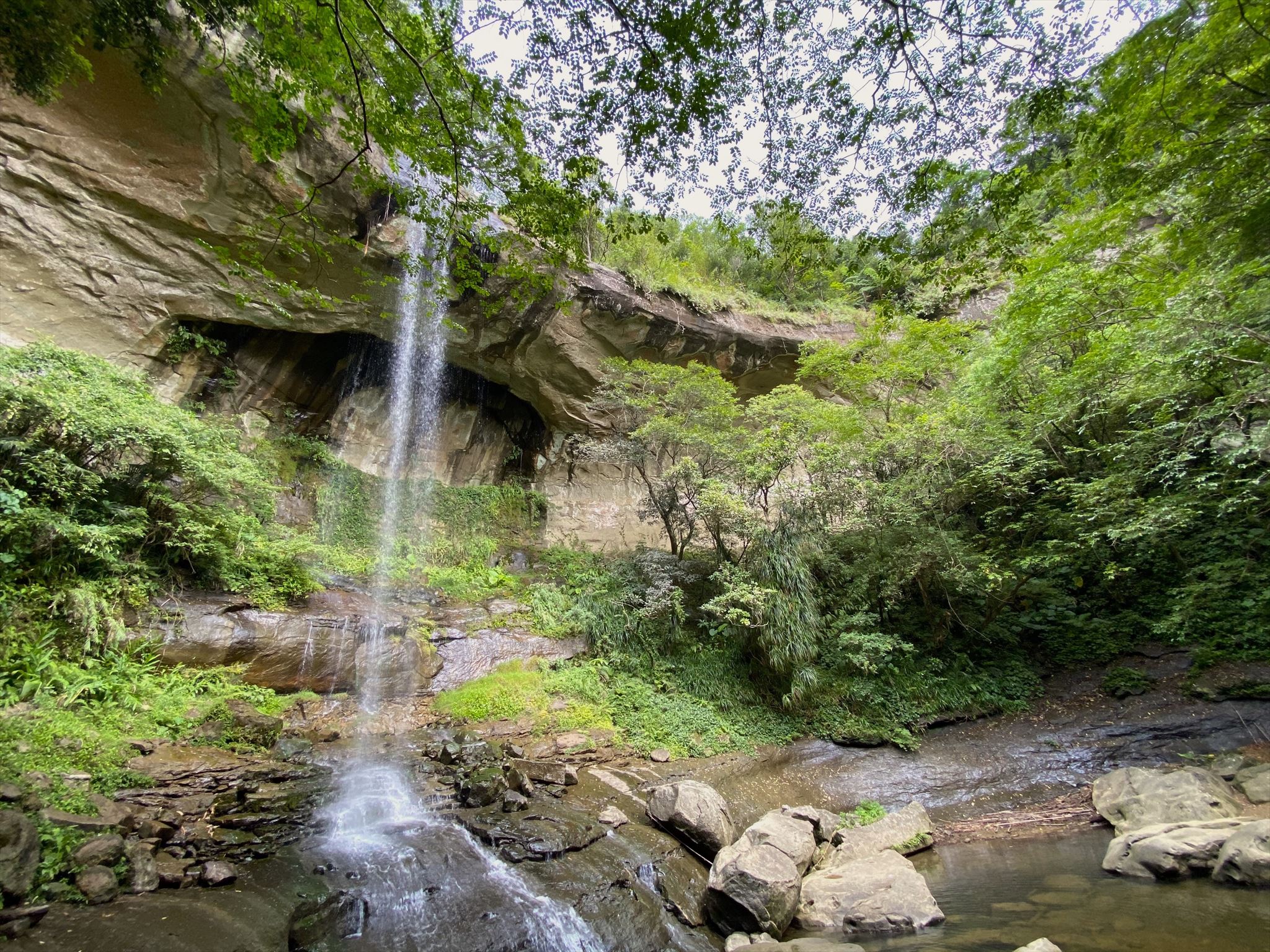
枇杷洞瀑布的獨特處
枇杷洞瀑布的崖面有明顯的地層分層,該區域斷層活動產生瀑布與露頭,還可在瀑布處觀察沈積岩的差異侵蝕作用。
這個地質寶要做什麼?
辨識與觀察地層,區辨單一地層的組成。
枇杷洞瀑布
枇杷洞瀑布位在新北市三貂嶺,瀑布在基隆河上游處。三貂嶺步道總共有三個瀑布,依序為合谷瀑布、摩天瀑布、與枇杷洞瀑布,枇杷洞瀑布位在最高的海拔位置。
三貂嶺岩石類型與斷層
三貂嶺下方的沈積岩地層為中新世(2400萬至480萬年前)的南港層(1390)。 圖源自中央地質調查所。

南港層常見的岩石類型有塊狀砂岩夾頁岩、粉砂岩、和頁岩,有些岩層含有玄武岩質凝灰岩。此區域的砂岩通常是灰色與深藍色,粉砂岩通常為灰色或紅褐色,頁岩基本上是灰色,玄武岩質凝灰岩則大多是黑色或藍綠色。不過,這些岩石的顏色可能受到風化影響而改變。
三貂嶺周遭多處斷層,北方為五分山斷層與草濫斷層,南方為牡丹坑斷層,東北方為三貂嶺斷層。枇杷洞瀑布是斷層活動與差異侵蝕的產物。
枇杷洞瀑布的地層
地層是地球表面的一層沈積岩、泥土或火成岩,單一地層中內部一致性特徵高,可以與其他地層區分開來。一般來說自然作用時,單一地層會堆積於另一個地層上方,依循疊積律,最古老的地層會為在最下方的序列。地層通常會以一組不同顏色、不同組成物的分層樣貌呈現,可以在懸崖、採石場、或是河岸觀察到地層。
枇杷洞瀑布崖面可觀察到明顯的地層分層,從地質寶位置可觀察到南港層常見的岩石類型,包含塊狀砂岩夾頁岩、粉砂岩、頁岩,甚至是玄武岩質凝灰岩,各自具有可區辨的顏色與質地。每個單一地層水平地座落在另一地層上方,暗示未變形的地層序列。
枇杷洞瀑布崖面不同的地層形成於不同的年代。一般來說,單一地層由單一類型的岩石在特定一段時間中形成,有時候單一地層的岩石組成會夾雜其他類型的岩石。凝灰岩是種特別的岩石類型,它是火山碎屑岩,但有時卻具有沈積岩的特徵,其沈積規模取決火山活動的程度,若是火山活動規模不大,薄凝灰岩層可能夾雜在其他沈積物的地層之中。其他夾雜不同岩石的地層,像是砂岩夾雜頁岩,也是此區域常見的地層類型。
枇杷洞崖面有水平的岩石地層,不過崖面的垂直面不是平坦的模樣,枇杷洞瀑布最上層有巨大的突出,中間則是一個大型洞穴,河流的差異侵蝕可能是這個洞穴的原因,侵蝕作用讓地層更有區辨性。
The uniqueness of Piapdong Waterfall
Pipadong Waterfall’s cliff shows distinctive strata, or the layers of rocks. The activities of faults at the area produced the waterfall and outcrops. Clear differential erosion on the layers of sedimentary rock can be observed in front of the waterfall.
What to do with this earthcache?
Recognize and observe Strata. Distinguish the composition in the stratum.
Pipadong Waterfall
Pipadong Waterfall is located at Sandiaoling, New Taipei City. The waterfall is at the upper reach of Keelung River. There are total three waterfalls on the Sandioaling trail. Hegu Waterfall is the first one on the trail. Motian Waterfall is the second one. Pipadong Waterfall is the third one and it is at the highest altitude.
Rock types and Faults at Sandiaoling
The sedimentary layer underlying at Sandiaoling is Nankang Formation (1390) belonging to Miocene (24 Ma to 4.8 Ma ago). Picture from Central Geological Survey, MOEA.

Common rock types in Nankang Formation are Sandstone mixed with shale, Siltstone, and Shale. Some layers of rock contain basaltic tuff. The color of sandstone at the area is normally in gray and azure. The color of siltstone here is normally gray or reddish brown. The color of shale here is typically gray. The color of basalt tuff is usually dark or bluish-green. Their color may be changed with weathering.
Sandiaoling is surrounded by faults, Wufenshan Fault and Tsaoian Fault at north side, Mutangkeng Fault at south side, and Sandiaoling Fault at northern-east side. Pipadong Waterfall is the result of the fault activities and differential erosion.
Strata at Pipadong Waterfall
Stratum is a layer of sedimentary rock or soil, or igneous rock that was formed at the Earth’s surface. Stratum with internally consistent characteristic can be distinguished from the other layers. Each layer is generally lying upon another by natural process. By the law of superposition, the oldest stratum will be at the bottom of the sequence. Strata are typically seen as bands of different colored or different structured materials. Strata may be exposed in cliff, quarry, or river banks.
Clear strata can be observed at the cliff of Pipadong Waterfall. From the posted coordination of this earthcache, rocks commonly discovered in the Nankang Formation can be observed, including sandstone mixed with shale, siltstone, shale, and even basaltic tuff. They show distinctive appearance in different color and texture. Each stratum is lying horizontal on the other one, suggesting undeformed stratigraphic sequences.
Different layers of rock in the strata of Pipadong waterfall were formed at different time. Normally, a stratum is composed of one unique type of rock and is formed at a specific period of time. Sometimes, a layer of rock may be mixed with a thin layer of different type of rock. Tuff is an unique type of rock. It is the pyroclastic rock but sometimes with a sedimentary feature. The amount of tuff depends on the scale of the volcanic activity. If the amount of tuff is few at the time, a thin layer of tuff may be mixed within a layer of other type of sediments. Other stratum with mixed composition, like sandstone mixed with shale, is also common at the area.
The cliff of Pipadong waterfall shows horizontal layer of rock. However, they are not in a flat surface vertically. A giant protrusion is on the top of Pipadong Waterfall and a huge cave in the middle of the cliff. River's differential erosion might be the reason for the cave. Erosion makes strata more distinctive.

問題
1. 在枇杷洞崖面可觀察到多少個地層?
找到上方數下來第二層的深色地層。
2.1 該地層的厚度大約多少?
2.2 該地層是均質的。(是/否)
2.3 解釋與說明該地層均質與否的原因。提示:不同類型的岩石有不同的顏色與質地。
3. 請你、你的辨識物、或GPS裝置與最硬地層的底部一起拍照。
線上登錄這個地質寶,請寄到Geocaching.com的信箱,若有什麼問題,會再回覆你。
Question
1 How many layers of rock do you recognize at the cliff of Pipadong Waterfall?
Recognize the stratum with a deep color, second layer from the top.
2.1 How thick it the stratum?
2.2 This stratum is homogenous. (Yes/No)
2.3 Interpret the reason why (or why not) it is homogenous.
Hint: Different texture and color of different types of rock.
3. Photo the bottom of the hardest layer with you, your identifying item, or your GPS device.
Log this cache "Found it" and send me your suggested answers either via my profile, or via geocaching.com (Message Center) messaging, and I will contact you if there is a problem.
Public Transportation to Entrance A 大眾交通工具
Take train to Sandiaoling Station. Follow the entrance waypoint. 搭火車至三貂嶺車站,依入口座標進入步道。
Drive to Entrance B 開車
There is an entrance close to the waterwall if you drive. 若你開車的話,可以考慮比較靠近瀑布的入口。
Reference
Stratum @wiki
Stratigraphy @wiki
Law of superposition @wiki
瑞芳鎮公所鎮誌地理篇 p.26